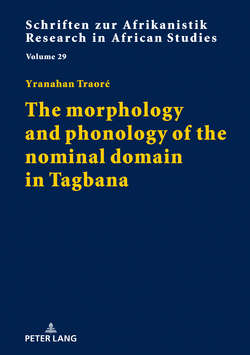Читать книгу The morphology and phonology of the nominal domain in Tagbana - Yranahan Traoré - Страница 9
На сайте Литреса книга снята с продажи.
ОглавлениеContent
Abstract
List of abbreviations
1 Introduction
1.1 Introduction
1.2 Tagbana
1.3 Social and political organization
1.4 Habitat, cultural life, economy, and religion
1.5 Fròʔò (Tagbana)
1.6 Previous works
1.7 Data collection
1.8 Structure of the book
2 The sounds of Fròʔò
2.1 Introduction
2.2 Phonemes of Fròʔò
2.3 Distinctive features
2.3.1 Features for consonants
2.3.2 Features for vowels
2.4 Feature geometry
2.4.1 Feature geometry for consonants
2.4.2 Feature geometry for vowels
2.5 Allophonic alternations
2.5.1 Voicing of stops
2.5.2 Allophonic relation between [g]; and [ŋ]
←11 | 12→
2.5.3 Free variation of [g];, [ɣ], [ʔ], or [Ø] in some Senufo languages
2.5.4 Allophonic relation between the palatal glide [j]; and palatal nasal [ɲ]
2.5.5 Vowel lengthening process before a liquid
2.6 Tones of Fròʔò
3 Syllable structure and syllabification
3.1 Introduction
3.2 Underlying syllable structure
3.2.1 Simple onsets
3.2.2 Complex onsets
3.2.3 V syllable: Nucleus
3.2.4 Vowel lengthening
3.3 Nasal syllables
3.4 Loanwords
3.5 Resyllabification
3.5.1 Vowel deletion leading to coda formation
3.5.2 Vowel deletion leading to complex onset formation
3.5.3 Liquid deletion
3.5.4 Fusion processes in Fròʔò
3.5.5 Summary of the fusion with sequences of two pronouns
3.6 OT applied on the syllable structure
3.6.1 Overview of OT
3.6.2 OT and syllable structure in Fròʔò
3.6.2.1 Syllables with an onset
3.6.2.2 Onsetless word-initial syllables
3.6.2.3 Onsetless word-internal syllables
3.6.2.4 Codas and coda-less syllables
3.6.3 Resyllabification by segment deletion
3.6.3.1 Vowel deletion resulting in codas
3.6.3.2 Word-final vowel deletion
←12 | 13→
3.6.3.3 Vowel deletion in morphological processes
3.6.3.4 Onset simplification by liquid deletion
3.6.3.5 Loanwords and repairs
3.6.4 OT and fusion
3.7 Conclusion
4 Nominal classes and the concord system in Fròʔò
4.1 Nominal classes
4.2 Noun classes in Niger-Congo languages
4.2.1 Noun class systems in Niger-Congo languages
4.2.2 Noun class systems in Gur languages
4.3 Noun class system in Fròʔò (Tagbana)
4.3.1 Nominal class 1
4.3.2 Nominal class 2
4.3.3 Nominal class 3
4.3.4 Nominal class 4
4.3.5 Nominal class 5
4.3.6 Nominal class 6
4.3.7 Nominal class 7
Conclusion
5 Agreeing/concording morphemes and alliterative concord
5.1 Introduction
5.2 Word order in the nominal phrase
5.3 Functional morphemes
5.4 Agreeing dependent functional morphemes
5.4.1 Pronouns, possessives, and possessive constructions
5.4.2 Interrogatives
5.4.3 Indefinite article
5.4.4 Demonstratives/relative pronouns
←13 | 14→
5.4.5 Deictic particle/clause-ending particles
5.4.6 Presentative
5.5 Illustration of agreement in dependent morphemes
5.5.1 Agreement in dependent functional morphemes of class 1
5.5.2 Agreement in dependent functional morphemes of class 3
5.5.3 Agreement in dependent functional morphemes of class 5
5.5.4 Agreement in dependent functional morphemes of classes 2, 4, 6 and 7
5.6 Morphosyntax and VI
5.7 The role of phonology
5.7.1 VI instructions as inputs in an optimality-theoretic analysis
5.7.2 Vowel and nasal harmonies
5.7.3 Total vowel harmony
5.7.4 Nasal harmony (vowel-consonant harmony)
5.7.5 Epenthetic [ʔ]
5.8 Discussion and additional comment on nouns
5.9 Conclusion
6 Nominal derivation in Fròʔò
6.1 Inflection and derivation
6.2 Denominal derivation
6.3 Deverbal nouns
6.3.1 Verbal root plus a CM
6.3.2 Special cases of deverbal nominalization
6.4 Deadjectival nouns
6.4.1 Adjectives in their citation form
6.4.2 Agreement in predicative adjectives
6.5 Conclusion
←14 | 15→
7 Compounding and complex noun formation
7.1 Noun + noun (N+N) compounds
7.1.1 Endocentric and exocentric compounds
7.1.2 N+N compounds with a single CM
7.1.3 N+N compounds with two CM (resulting in a nominal phrase)
7.1.4 N+N compounding and phonological effects
7.1.5 N+N+N compounding
7.2 Noun + verb (N+V) compounds: (Nominalroot + verbalroot) + nominalizer
7.3 Noun + adjective (N+A) compounds
7.3.1 Attributive adjectives
7.3.1.1 Class 1 and 2 nouns + adjective
7.3.1.2 Classes 3 and 4 nouns + adjectives
7.3.1.3 Classes 5 and 6 nouns with adjectives
7.3.1.4 Class 7 nouns compounded with adjectives
7.3.2 Adjective plè ‘small’
7.4 Compounds with more than one adjectival root
7.5 Conclusion
8 Summary and conclusion
Appendix
List of Figures
List of Tables
References
←15 | 16→←16 | 17→
